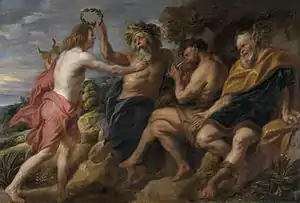Apollo as Victor over Pan
Apollo as Victor over Pan (German: Apoll als Sieger über Pan, Spanish: Apolo, vencedor de Pan, Dutch: Het oordeel van Midas (Ovidius, Met. XI, 146-179)), also known as Apollo's Victory over Marsyas, Tmolus declaring Apollo winner in musical competition with Pan (Ovid, Metamorphoses XI) and Apollo and Pan, is a 1637 oil-on-canvas painting by Flemish Baroque painter, draughtsman and tapestry designer Jacob Jordaens.[2][3][4]
| Apollo as Victor over Pan | |
|---|---|
| German: Apoll als Sieger über Pan, Spanish: Apolo, vencedor de Pan | |
 | |
| Artist | Jacob Jordaens |
| Year | 1636 - 1638 |
| Medium | Oil on canvas |
| Movement | Flemish Baroque |
| Dimensions | 180 cm × 270 cm (71 in × 110 in) |
| Location | Museo del Prado[1], Paseo del Prado, Madrid, Spain |
| Owner | King Philip IV, 1637-1665 (his death) Museo del Prado, 1794-present |
| Website | www |
Jordaens participated in a collaborative effort to decorate the Torre de la Parada near Madrid, done between 1636 and 1681, with one of the two paintings Jordaens contributed being Apollo as Victor over Pan (the other being Vertumnus and Pomona).[5]
Description
The subject is taken from Ovid's Metamorphoses, XI: 146-179. It depicts the flute playing contest between the god Apollo and the satyr Marsyas, which Marsyas ultimately loses. The painting shows the moments following the competition when Apollo furiously berates Midas, one of the contest's judges, for favoring the flute-playing ability of Marsyas over himself. Marsyas is presented in the canvas with human legs despite being a satyr.[6][7][8][9][10]
Influence
The canvas is Jordaens' interpretation of an earlier painting by Peter Paul Rubens entitled Apollo and Marsyas. Jordaens' painting of the Rubens canvas was then copied by Juan Bautista Martínez del Mazo, the Spanish Baroque painter and son-in-law of Diego Velázquez, the royal painter for King Philip IV of Spain. As chamberlain of the palace, Velázquez was responsible for acquisition, management and distribution of royal collections of paintings, tapestries, and sculpture which allowed him to decorate the Pieza Principal chambers of the Royal Alcázar of Madrid with Mazo's copy of the original Jordaens painting. Velázquez then depicted the copy of Apollo as Victor over Pan in the background of his own canvas, Las Meninas, which has been recognized as one of the most important paintings in Western art history, effectively creating a painting within a painting.[11][12][13][14][15]
In 2014 the Museo del Prado loaned the painting, along with nine other works from its collection by Peter Paul Rubens, Anthony van Dyck, Frans Francken the Younger and others, to the Museo Carlos de Amberes for the period of one year.[1]
References
- Lorena Muñoz-Alonso (4 November 2014). "New Madrid Museum Sets Focus on Flemish Old Masters". Artnet.com. Retrieved 14 March 2019.
- Ramón-Laca, Luis (2018). "A Virtual Three-Dimensional Model of Las Meninas: Paradox or Mirror Image?". Leonardo. 51 (4): 492–497. doi:10.1162/leon_a_01331. S2CID 57566046.
- Adams, Arron (2016). Jakob Jordaens: His Palette. Italy: Arron Adams. ISBN 9788892594548.
- Apoll als Sieger über Pan von Jacob Jordaens Accessed March 15, 2019.
- Vieghe, Hans (May 1968). "Jacob Jordaens's Activity for the Torre de la Parada". The Burlington Magazine. 110 (782): 262–268. JSTOR 875639.
- Ingram, Kevin (2018). Converso Non-Conformism in Early Modern Spain: Bad Blood and Faith from Alonso de Cartagena to Diego Velazquez. Saint Louis University, Madrid: Palgrave MacMillan. p. 222. ISBN 9783319932361.
- Van Eldere, D. (1992). Ovidiaanse thematiek in het werk van Jacob Jordaens. Antwerp. pp. 91–163.
- Yotova, Raya (2018). Jacob Jordaens: Drawings & Paintings (Annotated). Raya Yotova. ISBN 9788829577682.
- Searle, John R. (1980). ""Las Meninas" and the Paradoxes of Pictorial Representation". Critical Inquiry. 6 (3): 477–488. doi:10.1086/448060. S2CID 162387999.
- van Gelder, J.G. (1966). "Rubens Drawn by Jordaens". Master Drawings. 4 (3): 286–288+336–337. JSTOR 1552847.
- Kubler, George (1966). "Three Remarks on the Meninas". The Art Bulletin. 48 (2): 212–214. doi:10.2307/3048367. JSTOR 3048367.
- David Dollenmayer (30 September 2010). "The Painter's Painter: Velázquez After 350 Years". The New York Review of Books. Retrieved 15 March 2019.
- "Velázquez's Las Meninas". SUNY Oneonta. Retrieved 15 March 2019.
- Apollo and Marsyas by Peter Paul Rubens, 15 March 2019
- Las Meninas: Is This The Best Painting In History? Published Jan 20, 2016. Accessed March 15, 2019.